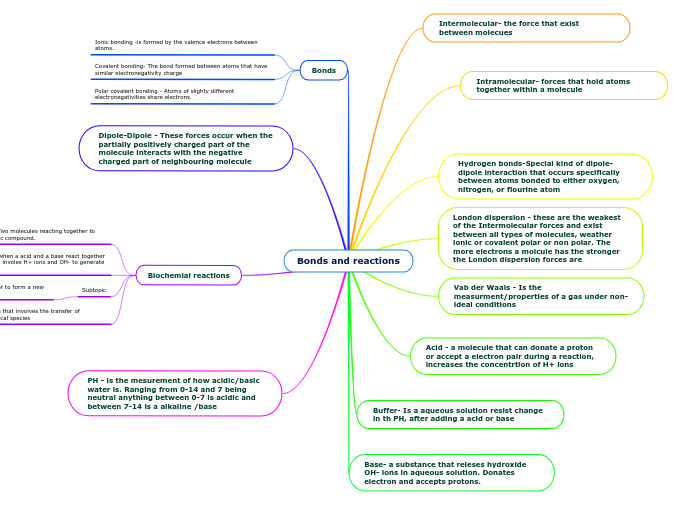Bonds and reactions
Intermolecular- the force that exist between molecues
Intramolecular- forces that hold atoms together within a molecule
Hydrogen bonds-Special kind of dipole- dipole interaction that occurs specifically between atoms bonded to either oxygen, nitrogen, or flourine atom
London dispersion - these are the weakest of the Intermolecular forces and exist between all types of molecules, weather ionic or covalent polar or non polar. The more electrons a molcule has the stronger the London dispersion forces are
Vab der Waals - Is the measurment/properties of a gas under non-ideal conditions
Acid - a molecule that can donate a proton or accept a electron pair during a reaction, increases the concentrtion of H+ ions
Buffer- Is a aqueous solution resist change in th PH, after adding a acid or base
Base- a substance that releses hydroxide OH- ions in aqueous solution. Donates electron and accepts protons.
Bonds
Ionic bonding -is formed by the valence electrons between atoms.
Covalent bonding- The bond formed between atoms that have similar electronegativity charge
Polar covalent bonding - Atoms of slighty different electronegativities share electrons.
Dipole-Dipole - These forces occur when the partially positively charged part of the molecule interacts with the negative charged part of neighbouring molecule
Biochemial reactions
Condensation reaction- Two molecules reacting together to form a new single organic compound.
Neutralization reaction -when a acid and a base react together to form water and a salt, involes H+ ions and OH- to generate water
Subtopic
Hydrolysis reaction- A reaction involving water to form a new substance.
Redox reaction- Reaction that involves the transfer of electorns between chemical species
